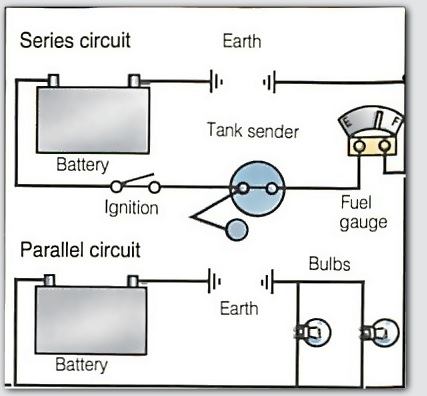— Activity —- Series and parallel circuits 7/25
「テキスト」
www.howacarworks.com/basics/how-car-electrical-systems-work.amp
「1」図示:直列と並列
https://twitter.com/eigo_tsukai/status/1413694128479637506?s=21
「2」写真:燃料タンクの中の送信機

「3」写真:燃料ゲージ

「おまけ」
🎥ダイオード
https://m.youtube.com/watch?v=JNi6WY7WKAI
参考URL:
https://elite-lane.com/negative-positive-semi-conductor/
真性半導体であるシリコンは、そのまま使用しても自由電子は動きにくく、絶縁体同様、通電しません。半導体として電気を流す為には、不純物のリンやホウ素を真性半導体のシリコンに混ぜ込むことで👇
P型半導体
- P型半導体は、ポジティブ(Positive)型半導体
- ホウ素、アルミニウム 等を不純物として添加・・・P型半導体
- P型半導体・・・陽電気を帯びている半導体
- 電荷を運ぶキャリアとして正孔(ホール)が利用
- 正の電荷を持つ正孔(ホール)が移動することで電流が発生
N型半導体
- N型半導体は、ネガティブ(Negative)型半導体
- リン、ヒ素 等を不純物として添加・・・N型半導体
- N型半導体・・・陰電気を帯びている半導体
- 電荷キャリアとして自由電子が利用
- 負の電荷を持つ自由電子がキャリアとして移動することで電流が発生

— Vocabularies —-
①
A circuit →電気回路
one component →機器(負荷)
connected in series one after the other →一つから次の一つへ直列で結線される👆「1」図示:直列と並列
in parallel side by side →一つ一つが並列で結線される👆「1」図示:直列と並列
②
designed to have a degree of resistance →抵抗値が設定される
it consumes a certain current to glow normally. →光るために適切な電流が消費される
③
electric current would have to go through one headlamp to get to the other →もし二つのヘッドランプが直列に結線されていたら、電流はランプを一つ一つ、順に通過していく👆「1」図示:直列と並列
④
The current would encounter the resistance twice →電流は抵抗(ランプ)を2回通過することになり👆「1」図示:直列と並列
double resistance would halve the current →二つのランプは電流を二分する👆「1」図示:直列と並列
halve →半減させる
glow only feebly →弱々しく光る
⑤
electricity goes through each bulb only once →それぞれのランプを1回だけ通過する👆「1」図示:直列と並列
⑥
must be connected in series →直列で結線しなければならない👆「1」図示:直列と並列
the sender in the fuel tank varies its resistance according to the amount of fuel in the tank →燃料タンクの中の送信機は可変抵抗であり燃料タンクの中の燃料の量に合わせて変化する👆「2」写真:燃料タンクの中の送信機
variable resistance →可変抵抗
‘sends’ a small electrical current to the fuel gauge. →電流をゲージ(計器)へ送信する👆「3」写真:燃料ゲージ
⑦
varying resistance in the sender will affect the position of the needle on the gauge →送信機の可変抵抗は計器の中の針の位置をかえる
— Reading —-
”Reading” の音声ファイル
①・A circuit usually includes more than one component, such as bulbs in the lighting circuits. It matters whether they are connected in series one after the other or in parallel side by side.
②・A headlamp bulb, for example, is designed to have a degree of resistance so that it consumes a certain current to glow normally.
③・But there are at least two headlamps in the circuit. If they were connected in series, electric current would have to go through one headlamp to get to the other.
④・The current would encounter the resistance twice, and the double resistance would halve the current, so that the bulbs would glow only feebly.
⑤・Connecting the bulbs in parallel means that electricity goes through each bulb only once.
⑥・Some components must be connected in series. For example, the sender in the fuel tank varies its resistance according to the amount of fuel in the tank, and ‘sends’ a small electrical current to the fuel gauge.
⑦・The two components are connected in series so that the varying resistance in the sender will affect the position of the needle on the gauge.